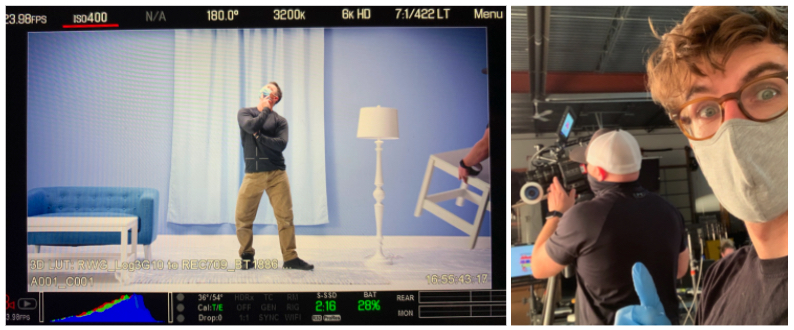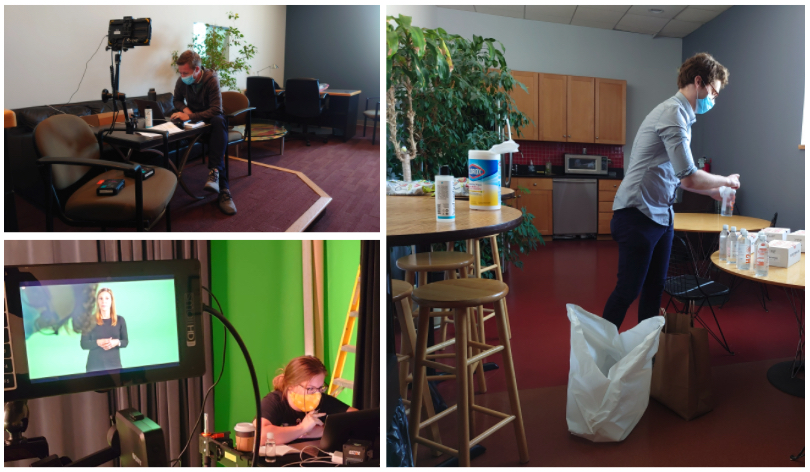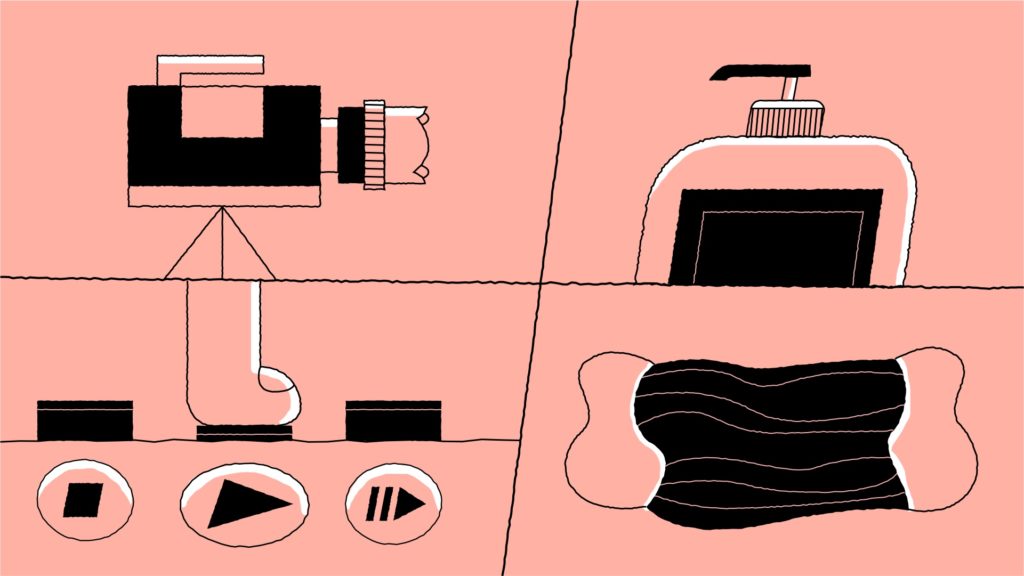Although Demo Duck started ten years ago as an animated explainer video company, we soon started offering live action explainers only two years later in 2013. Admittedly, it took some time for this arm of the company to ramp up and even more time for us to really hit our stride with live action productions.
Given that my own video experience prior to joining the team was primarily with live action, I’ve been energized these past few years as we’ve produced really exciting and vibrant work. A few personal favorites come to mind, including our stop motion commercial for Happy Cards, a live action explainer for Showpad, and countless customer testimonials all over the US, including Puerto Rico.
That’s why when COVID-19 shut down our ability to tackle live action productions in the early part of 2020, it felt like we had an important tool taken from our creative toolbox. We had developed great processes and connections within the Chicago video production community, but suddenly, everything came to a quick halt.
Before proceeding further, I want to note that on the long list of problems caused by COVID-19, not being able to produce live action video is a very low priority. However, we thought that sharing some of our experiences might be helpful to other members of the video production industry who may be looking for advice on safely navigating live action production during the pandemic.
Demo Duck was able to safely produce a few live action videos this summer and will continue to do so as the year progresses. Here’s a look into many items that our team discussed and decided on leading up to, during, and after those recent productions.
Production Phases
In early May, Demo Duck had a few productions that were delayed from April and we were waiting to figure out how or if we’d be able to move forward with them. Much like in other areas of the country, there was a bit of gray area in Chicago around what constitutes an essential business and whether video production qualified. Regardless, we knew that we didn’t want to be on set unless our team, clients, talent, and production partners felt safe and our region had some sort of grasp on COVID-19.
We decided the easiest thing for us to do was to tie different complexities and sizes of productions to different phases of Restore Illinois, in which the state government outlines what types of activities the residents can participate in by looking at different data points related to COVID-19.
Here’s the breakdown of how Restore Illinois is linked to our production types:
- PHASE 1: No live action productions
- PHASE 2: Productions are limited to 5 people on set
- PHASE 3: Productions are limited to 10 people on set
- PHASE 4: Productions are limited to 20 people on set
- PHASE 5: Back to standard production processes
We could now prepare ourselves for any upcoming announcements and could make sure that if our region in Illinois moves forward or backward, we have a plan in place for how we can achieve the vision for the live action video production while still keeping everyone safe.
Production Planning
For one of our clients with a July deadline, we decided that the most efficient way to finish on time was to do as much pre-visualization and post-production before getting into the studio. This involved creating all of the style frames (no small feat across 30+ videos), keying and color correction, identifying our music, and filming scratch versions of key shots—all before stepping foot in the studio.

The other side of the timing puzzle was following how our region was trending in terms of COVID-19 cases and projecting what phase we’d be in for our target production dates. Luckily, we did get some lead time on when Restore Illinois phases would be shifting (~2 weeks) from local officials. This allowed us to lock in talent, location, and crew a few weeks out from when we’d want to begin filming. Prior to that point, we had been in communication with each of those partners and explained to them that we had some timing ranges of when the production would be and got a sense of whether they had flexibilities in their schedules or not. So when we got the green light, we were collectively ready to hit the ground running.
On Set Protocol
Whether there were 5 or 10 people on set (we have yet to have more than 10 people), most of our on set protocols remain the same. We pulled from a variety of sources, including the AICP guidelines, to create our own rules and regulations in PDF form. This is shared with everyone early on in the production conversations to increase compliance ahead of time.
Following those protocols was key, but we quickly learned that doing so can take a bit more out of you than a normal production day. You’re balancing how to execute on your creative vision while still keeping a relatively long list of rules in mind as you work through the shot list. It can get a little tiring! We found that having more built-in breaks throughout the day, longer lunches, and easy access to the outdoors all helped keep up momentum and morale.

We also learned the value of spreading out the schedule as much as possible. Start at 8:30am instead of 8am. Don’t always rush to get way ahead of schedule if you’re moving quickly. And leverage a pre-light day wherever possible. It’s important to keep people’s immune systems strong, and their energy up when external forces are adding a layer of stress to everything on set and beyond.
Remote Video Village
The biggest safety aspect we aim to communicate is that no one has to be on set if they do not want to. Despite all of our safety protocols and careful planning, there will still be people who are understandably uncomfortable with being around others. It’s true for Ducks, true for the crew and true for clients.
This put increased importance on having a high-quality remote video village setup. Luckily, both of the studios we produced our work in, 2nd Cine and Resolution Digital Studios, had their remote offerings updated and detailed by mid-May. This allows remote clients and the commercial video production team members to hop onto a Zoom call to see and hear what the camera sees and hears. This helps to get frame approved before rolling, aligns everyone on what’s on the slate, and lets viewers easily share production snaps (via screenshots) with anyone they’d like. Though there are fun aspects to being on set, it’s also pretty cool to produce a shoot while still wearing your PJs.
Ongoing Improvements
Never ones to be satisfied with simply getting everything shot safely and calling it a wrap, Demo Duck wants to make sure we’re achieving our safety goals and soliciting any advice from those who joined us on set. That’s why we’ve begun sending out an anonymous survey to participants asking them about their experience and any deficiencies in our operation. Here are some up-to-date responses and, we’re proud to report we’ve received high marks thus far.
- Overall, how well did you feel the shoot went? Average Score 5
- How safe and comfortable did you feel on set? Average Score: 4.875
- “Honestly the shoot went off without a hitch. Very smooth. Nothing to comment on.”
- “My team felt very safe and had no issues. Based on work with others, Demo duck is ahead of the curve on providing the best environment.”
- “I wasn’t sure if it was mentioned that no coffee would be provided or not. If I had known I would have brought my own coffee.”
- “Somehow provide the 3PM coffee”
These results were great to see and were the product of a lot of hard work and critical thinking by our team and industry as a whole. We now provide an abundance of iced coffee on our set, by the way. Who knows what the future of live action production will bring in these next few months, but if we feel it’s safe for us as individuals and our larger community to produce great video content – we’ll be working to make it happen.
Of course, local regulations and guidance are always changing, especially for video productions that involve travel to and from Chicago, so we’ll be continuously evolving our protocols to stay safe and compliant.
If you have any questions about our approach to live action production during the pandemic, or are looking to produce some live action content of your own, please drop us a line!
